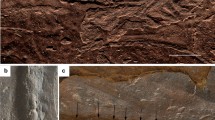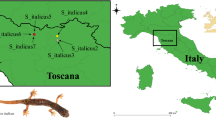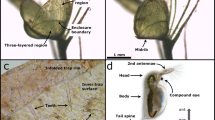Abstract
THE Corixidae are a family of aquatic bugs living on the habitat bottom. The front legs of both sexes are used for collecting food, the tarsi (or paleæ) being highly specialized for this purpose. The middle legs have retained their ambulatory form, and the long claws are used for anchoring the insect to the habitat bottom during feeding. The hind-legs are used for swimming, the tibiæ and tarsi being specially flattened for this purpose.
This is a preview of subscription content, access via your institution
Access options
Subscribe to this journal
Receive 51 print issues and online access
$199.00 per year
only $3.90 per issue
Buy this article
- Purchase on Springer Link
- Instant access to full article PDF
Prices may be subject to local taxes which are calculated during checkout
Similar content being viewed by others
References
Kirkaldy, G. W., J. Quekett Mic. Club, 8 (1901).
Mitis, H. von, Z. Morph. Oekol. Tiere, 30, 479 (1935).
Saunders, E., The Hemiptera-Heteroptera of the British Islands, London (1892).
Butler, B. A., A Biology of the British Hemiptera-Heteroptera, London (1923).
Macan, T. T., Freshw. Biol. Assoc. Pub., 16, 1 (1956).
Southwood, T. R. E., and Leston, D., Land and Water Bugs of the British Isles, London (1960).
Author information
Authors and Affiliations
Rights and permissions
About this article
Cite this article
POPHAM, E. The Function of the Paleal Pegs of Corixidae (Hemiptera Heteroptera). Nature 190, 742–743 (1961). https://doi.org/10.1038/190742a0
Issue Date:
DOI: https://doi.org/10.1038/190742a0
This article is cited by
-
Laut�u�erungen und Verhalten von Sigara striata und Callicorixa praeusta (Corixidae Leach., Hydrocorisae Latr.)
Zeitschrift f�r Vergleichende Physiologie (1968)
Comments
By submitting a comment you agree to abide by our Terms and Community Guidelines. If you find something abusive or that does not comply with our terms or guidelines please flag it as inappropriate.



